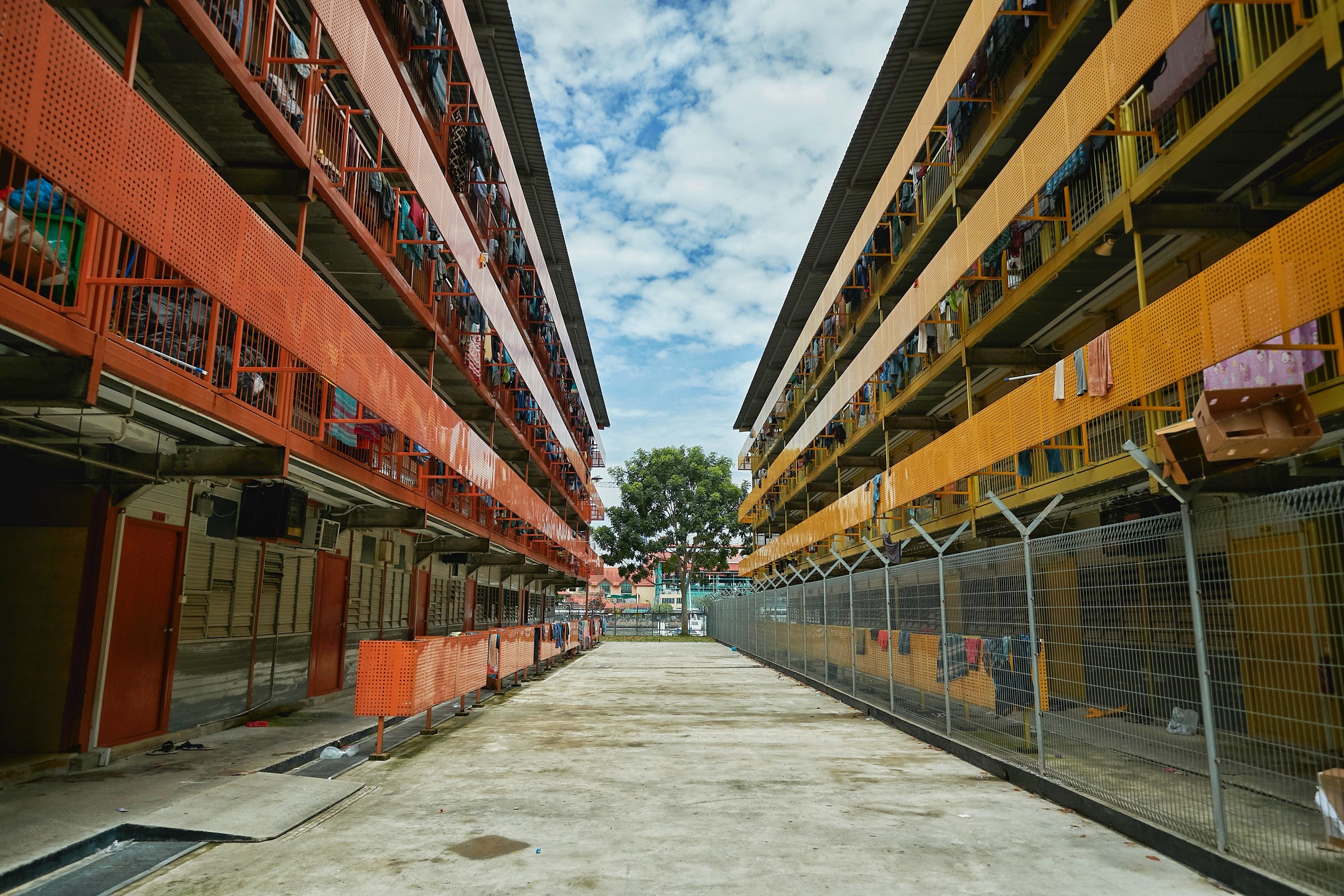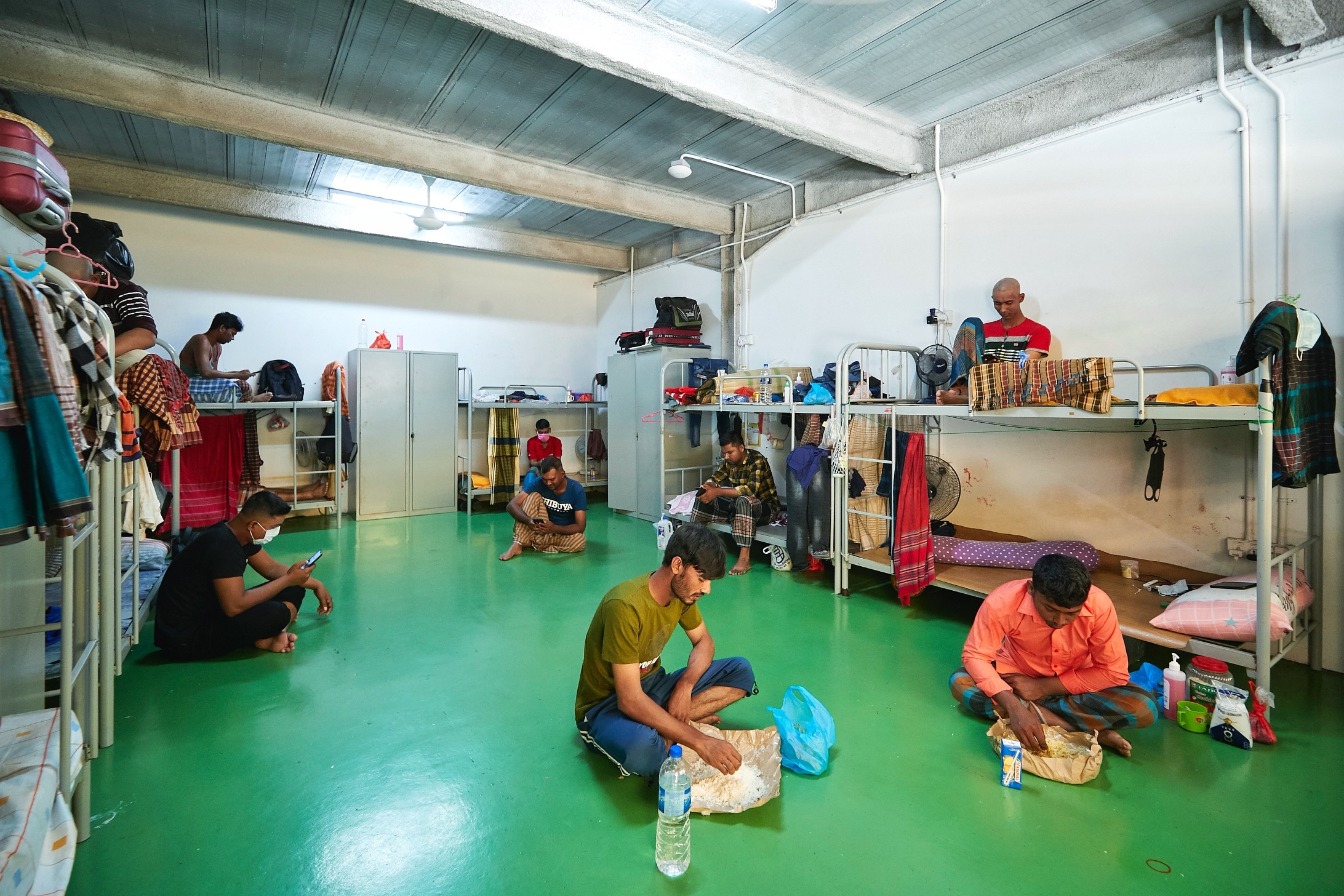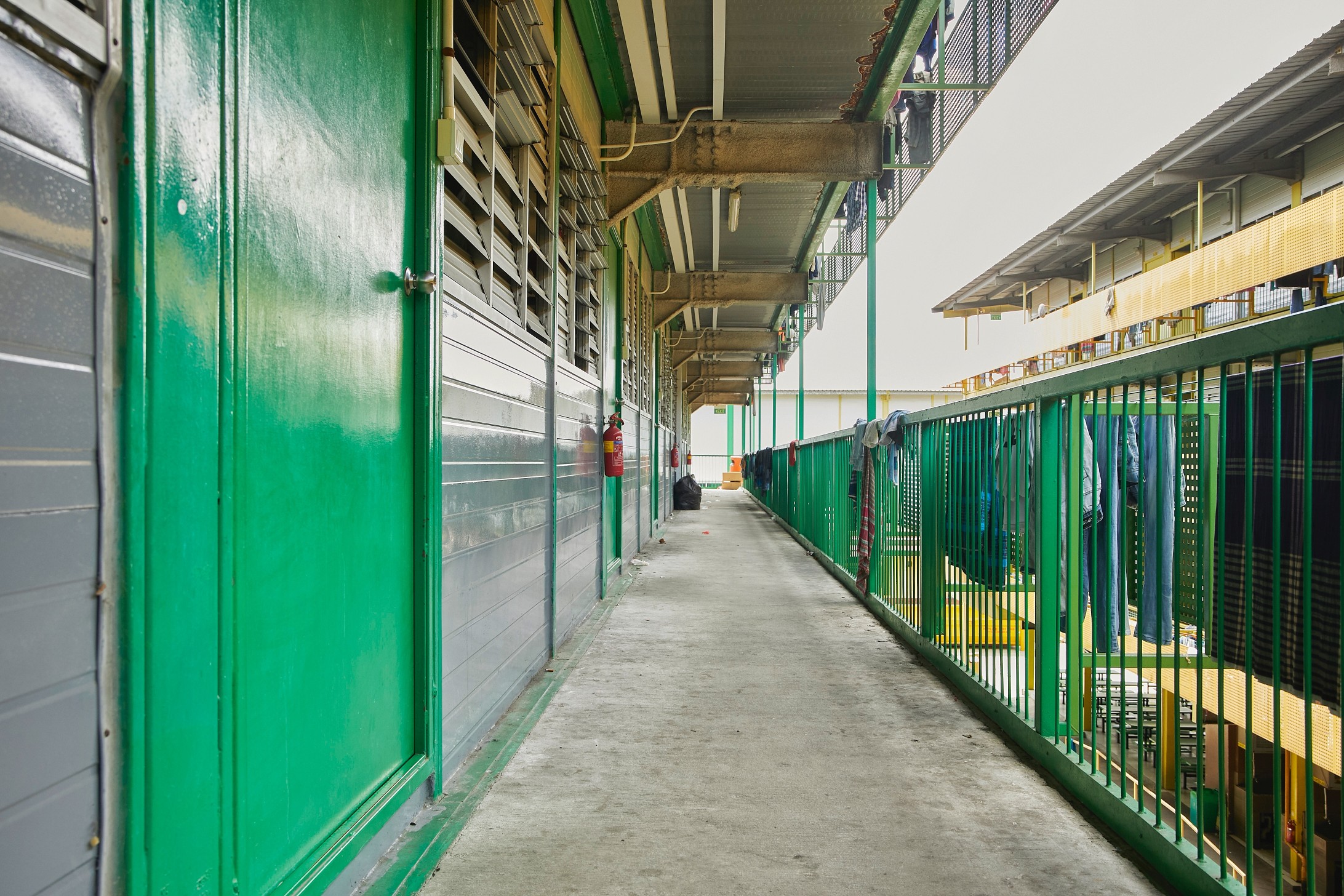Follow us on Telegram for the latest updates: https://t.me/mothershipsg
The S11 dormitories along Seletar North Link (S11 Dormitory @ Punggol) and Tanah Merah Coast Road (Changi Lodge II) came under the spotlight earlier this year when they were one of the earliest dormitories to produce Covid-19 clusters.
The then-rapidly growing number of Covid-19 cases reported in migrant worker dormitories prompted renewed calls for better dormitory living conditions and overall better treatment of migrant workers themselves in Singapore.
Three months on, migrant worker dormitories are still under lockdown. However, the government is set to finish testing all the workers in the dormitories by this week and has promised to bring up the standard of living conditions in the dorms once the pandemic is over.
And so Mothership caught up with Johnathan Cheah, founder of S11 Group which manages the Changi Lodge II and S11 Dormitory @ Punggol, to better understand what goes into running a migrant worker dormitory in Singapore.
Running a migrant worker dorm: A self-sufficient village
From what Cheah describes, bidding for and running a dormitory business is a largely prescriptive affair.
Operators have to bid for pieces of land that have been earmarked for dormitories. Once successfully bidded, the construction begins, according to “pre-defined” specifications.
These specifications include space requirements (4.5 square metres of living space per resident), maximum number of residents per floor, and provision of toilets (one for every 15 residents) and other amenities (like cooking areas, TV rooms, and gyms).
There will also be a commercial space allowance which is usually used to open a supermarket or minimart.
The only difference between dormitories is the way they run it. Some, like S11, choose to include amenities like a cinema theatre and a sheltered bus bay for its residents.
"I think one way to look at it is, as dormitory operators, especially for bigger dormitories, we are like running a small town...where we handle the security, we handle the amenities, the cleanliness, the maintenance, so it is like running a town. In fact, 14,000 for [S11 Dormitory @ Punggol], 14,000 is possibly bigger than Toa Payoh."
 One of the S11 dorms. Via MOM.
One of the S11 dorms. Via MOM.
And running a population bigger than Toa Payoh — in a place smaller than Toa Payoh, of course — comes with its own set of challenges.
One such challenge is the issue of safety and security, especially during the peak hours where a large number of migrant workers leave or enter the dormitory or at night when most do their cooking and washing.
Cheah has around 20 operational executives at S11 Dormitory @ Punggol to handle ground operations while another 20 outsourced workers handle the dormitory’s security.
Main concerns are maintenance issues
For such a massive operation, the most common issues that Cheah faces from his residents are, perhaps unsurprisingly, maintenance-related, like leaking taps or failed fans and lights.
Before the Ministry of Manpower (MOM) came up with an app — DormWatch — for providing feedback about housing issues, residents in Cheah’s dormitories could call the guard house to report issues.
Leaking taps and spoiled lights aside, how do Cheah's migrant worker residents feel about their living conditions?
Cheah is quick to point out that standards for migrant worker housing have improved over the last 10 years, in part due to the Foreign Employee Dormitories Act (FEDA).
"I recall when I was younger, much younger, 20 over years ago, the first time I’ve seen worker housing, it broke my heart. I’ve seen quadruple decks in a factory before. I did not imagine that a quadruple deck bed could exist at all. You look at the place, there is a stench. You look at the number of toilets, the bathrooms, in a setup like that. It is heartbreaking."
20 years on, the dormitories today with more space, less queuing, and more amenities is quite an improvement, according to Cheah.
"I think we are happy, we know that the workers are also happy that they have this communal space."
Specifically though, regarding the accusations of cramped living conditions, Cheah counters with the argument that his 12-man Punggol dormitory rooms are about 48 square metres big each. This is about the size of a two-room Flexi-flat.
"You will find that it is actually very spacious. When they move out of the room, the corridors are about 1.5 metres wide, staircase also similarly 1.5 metres wide....So the photos or videos that you see it being very cramped is often or not is because there are a lot of activities happening especially during the [Covid-19 pandemic] in the first few days where they all come out to try and understand what’s going on. That’s why you see the crowded photos."
So how much exactly does a dormitory operator charge per bed?
There is a common misconception that workers have to fork out money for their dormitory accommodation. Accommodation costs are forked out by the workers' companies. This cost cannot be deducted from workers' salaries.
The standard cost across the industry for a bed is between S$250 and S$300. Some companies, in a bid to save money, will request to squeeze more workers into one room.
Others, says Cheah, have been known to fork out more for their workers' comfort:
"We have clients that will want their workers’ rooms to be converted to air-conditioned. So we do that for the companies on request. Some of them also want to put in TVs, fridges for their workers. So we have some companies that actually do that for their workers."
 Migrant worker residents in their dorms after an inter-agency task force went in to clean up the dormitory following reports of overflowing trash and flooded toilets. Image via MOM.
Migrant worker residents in their dorms after an inter-agency task force went in to clean up the dormitory following reports of overflowing trash and flooded toilets. Image via MOM.
Razor-thin margins in dormitory industry
Squeezing 10 to 12 workers in a room is quite the norm because of the razor-thin margins that dormitory operators earn.
The dormitory industry might appear big, says Cheah, because of the sheer size of the migrant worker population but the truth is there are only a handful of players in this industry.
A lot of the revenue — Cheah estimates this to be about 60 to 70 per cent — goes into rental for the land.
"So if you collect $1 basically 60 cents go to the government. Straight off for land rent. That excludes the cost of construction. The cost of construction is something that you recover over a period of time."
Utilities account for a smaller, but not insignificant chunk — about 20 to 30 per cent — of revenue, says Cheah.
Part of this goes to paying, for instance, a staggering S$250,000 water bill every month at the Punggol dormitory. This amount is after optimising cleaning activities and having a water recycling system. This is one of his biggest monthly expenses after deducting land rental.
In 2015, Cheah told The Businesss Times that his Changi Lodge 2 generated an annual revenue of S$15 million. The paper also reported that the Punggol Lodge would bring in an annual revenue of S$55 million when operating at full capacity.
Costs are up
So five years on, are Cheah's dormitories bringing in S$70 million (or more) in revenue?
"No, definitely not. I think with Covid-19, it is definitely not the case," he says.
Now that many construction companies aren't able to proceed with their projects, they face cash flow problems which mean that dormitory operators like Cheah aren't getting paid.
Cheah himself estimates that his revenue has fallen 60 per cent.
Having more workers quarantined in the dormitories means that utilities, cleaning, and refuse collection — all of which increase the cost of running a dormitory — also went up.
He estimates that utilities cost has gone up by 100 per cent ("Because now they use the toilets more often, they bathe more often.") while refuse collection has increased by three to four times.
Having more duty personnel on the ground to coordinate medical workers and food distribution has also contributed to another 50 to 150 per cent increase in manpower costs.
Why can't we do away with communal living?
The general consensus is that the close, communal living conditions of migrant workers in dormitories have contributed to the explosion of Covid-19 cases in Singapore.
To that end, the Singapore government recently announced that it will embark on a building programme to produce dormitories with better standards, including more living space, fewer beds per room, and the provision for more sick bays.
So why not just do away with communal living?
According to Cheah, the alternative to communal living would be to have facilities like a bathroom and cooking area attached en suite to migrant workers' room — much like apartment living.
While this arrangement would be great in the event of another pandemic, it is just too costly. These are costs that will eventually trickle down to the end user — like a HDB flat buyer, says Cheah.
"We know very well at the end of the day we need to strike a balance. We want the rooms to be comfortable, safe. We also want the amenities to be sufficient whether or not it is toilet, whether or not it is bathroom, whether or not it is cooking area.
It shouldn’t be the case that they have to queue to use such facilities. I think that is very important. But we also need to strike the balance because of cost."
One way, says Cheah, is to have communal kitchens at every level instead of per block.
 Communal living is here to stay, but more facilities can be provided to reduce the density of workers, says Cheah. Image via MOM.
Communal living is here to stay, but more facilities can be provided to reduce the density of workers, says Cheah. Image via MOM.
Singaporeans have to learn to live with migrant workers in the community
Lastly, Singaporeans also have to learn to live with migrant workers close by.
Cheah shares that when he started building his dormitory in Punggol, he started receiving feedback from alarmed Punggol residents, asking why a dormitory was being constructed in Punggol town.
"Actually Punggol dormitory location is not within the town, it is actually a bit out of the Punggol town but it is about a kilometre away. So in terms of view, yes, you can see the dormitory from the nearby HDB estate."
A few years after the Punggol dormitory started operations, more HDB flats started popping up near the edge of Punggol and near Cheah's dormitory. The new residents were shocked to see a migrant worker dormitory nearby, says Cheah.
"Nobody wants to hear about dormitories, nobody is interested to know that there is a dormitory near their home. Nobody is interested to know how foreign workers live or work."
This is perhaps the reason why, accompanying the announcement of the new dormitory standards, was a line urging Singaporeans to give their support in appreciating workers who keep the country going.
Top image via MOM and screengrab from video call.
If you like what you read, follow us on Facebook, Instagram, Twitter and Telegram to get the latest updates.
